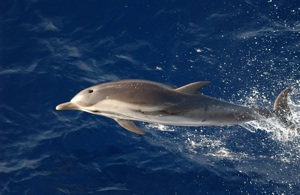Marine Mammal Species Description
Striped Dolphin
Stenella coeruleoalba
(Meyen, 1833)

Photo credit: Wayne Hoggard NOAA/NMFS/SEFSC
Classification
Order: Cetacea
Family: Delphinidae
Alternate Common Names: Streakers
Status: protected under MMPA
Description:
Length: 6-8 ft (1.8-2.5 m)
Weight: 240-350 lbs (110-160 kg)
Striped dolphins have a long beak with a distinct crease between their melon and their beak. Striped dolphins also have a falcate dorsal fin. They have dark gray/blue coloration on their backs, fluke, flippers, and beak, which fades to white on their bellies. They have dark thin stripes that start at the eye and run along their paler sides. At least one of the stripes extends the length of the body from the eye to the anus and another runs from their eye to their flipper.
Habitat:
Striped dolphins occur in the warm temperate and tropical deep oceans off the continental shelf (up to 3,300 ft (1000 m) deep). Normally they occur in schools with less than 200 individuals, but some schools can be larger with several hundred individuals.
Feeding:
Striped dolphins eat fish, squid, and shrimp. They forage most often at dusk or early evenings when deeper dwelling fish species move closer to the surface. They forage as deep as 650-2,300 ft (200-700 m).
Reproduction:
Female striped dolphins reach sexual maturity at 5-13 years. Male striped dolphins reach sexual maturity at 7-15 years. Sexually mature individuals are about 6.9-7.2 ft (2.1-2.2 m) in length. The gestation period for striped dolphins is 12-13 months. Calves are weaned in one to two years.
Other:
The maximum life span recorded for a striped dolphin is 57 years. Some research suggests that contaminants (organochlorines and PCBs) may be the cause of some strandings of this species.
Distribution / Range:
Occurs in warm oceans, both temperate and tropical, around the world. Off the coasts North America in the east, striped dolphins have been seen all along the coast as far north as Canada. Their distribution follows the northern flowing Gulf Stream along the coast. In the waters off the west coast, striped dolphins are seen most often from southern California south.
Similar species:
Similar species that occur off the coast of the southeastern United States include common dolphins (Delphinus delphis), Clymene dolphins (Stenella clymene), and spinner dolphins (Stenella longirostris). All of these species lack the distinctive, bold stripe on the side of the striped dolphin.
Notes:
References:
Archer, F.I., II. 1999. Striped dolphin, Stenella coeruleoalba. In The Smithsonian Book of North American Mammals. Wilson, D.E. and S. Ruff, eds., 268-269. Smithsonian Institution in association with the American Society of Mammologists, Washington DC.
Archer, F.I., II. 2009. Striped Dolphin - Stenella coeruleoalba . In: Encyclopedia of Marine Mammals 2nd Ed. Perrin W.F., B. Würsig, and J.G.M. Thewissen, eds. Academic Press, New York, pp. 1127-1129.
Culik, B. 2010. Odontocetes. The toothed whales: "Stenella coeruleoalba". UNEP/CMS Secretariat, Bonn, Germany. http://www.cms.int/reports/small_cetaceans/index.htm. Accessed January 2012.
Hammond, P.S., Bearzi, G., Bjørge, A., Forney, K., Karczmarski, L., Kasuya, T., Perrin, W.F., Scott, M.D., Wang, J.Y., Wells, R.S. & Wilson, B. 2008. Stenella coeruleoalba. In: IUCN 2011. IUCN Red List of Threatened Species. Version 2011.2. www.iucnredlist.org. Downloaded on 09 January 2012.

 Marine Mammals of Georgia
Marine Mammals of Georgia